1993 CHEVROLET CORVETTE interior light
[x] Cancel search: interior lightPage 42 of 370
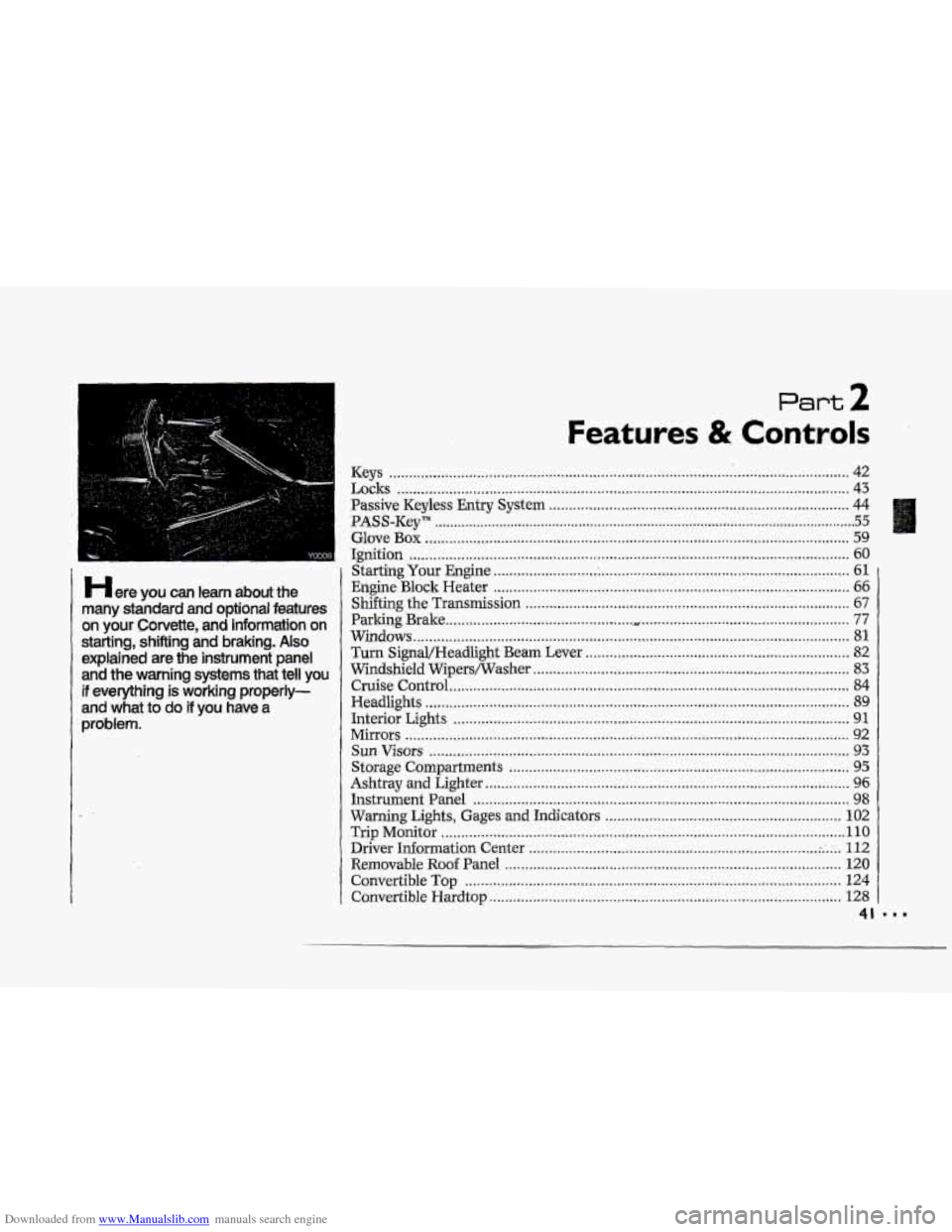
Downloaded from www.Manualslib.com manuals search engine !
....
+-
Here you can learn about the
many standard and optional features
on your Corvette. and information on
starting. shifting and braking . Also
explained are the instrument panel
and the warning systems that tell you
if everything is working properly-
and what to do if you have a
problem .
Part 2
Features & Controls
Keys ........................................................................\
........................................... 42
Locks ........................................................................\
......................................... 43
Passive Keyless Entry System ........................................................................\
... 44
Glove Box ........................................................................\
.................................. 59
Starting Your Engine ........................................................................\
.................. 61
Engine Block Heater ........................................................................\
................. 66
Shifting the Transmission ........................................................................\
......... 67
Parlring Brake ............................................... .................................................... 77
Turn SignaVHeadlight Beam Lever .................................................................. 82
Windshield Wipers~asher ........................................................................\
....... 83
Cruise Control ........................................................................\
............................ 84
PASS-Key'" ........................................................................\
....................................... 55
Ignition ........................................................................\
...................................... 60
Windows ........................................................................\
..................................... 81.
Headlights ........................................................................\
.................................. 89
Interior Lights ........................................................................\
........................... 91
Storage Compartments ........................................................................\
............. 95
Mirrors 92
Sun Visors ........................................................................\
................................. 93
Ashtray and Lighter ........................................................................\
................... 96
Instrument Panel ........................................................................\
...................... 98
Warning Lights, Gages and Indicators ........................................................... 1 02
........................................................................\
.......................................
Trip Monitor ........................................................................\
............................. 1 IO
Driver Information Center ........................................................................\
. .:. .... 112
Convertible Hardtop ........................................................................\
................ 128
Removable Roof Panel ........................................................................\
............ 120
Convertible Top ........................................................................\
...................... 124
41
Page 48 of 370
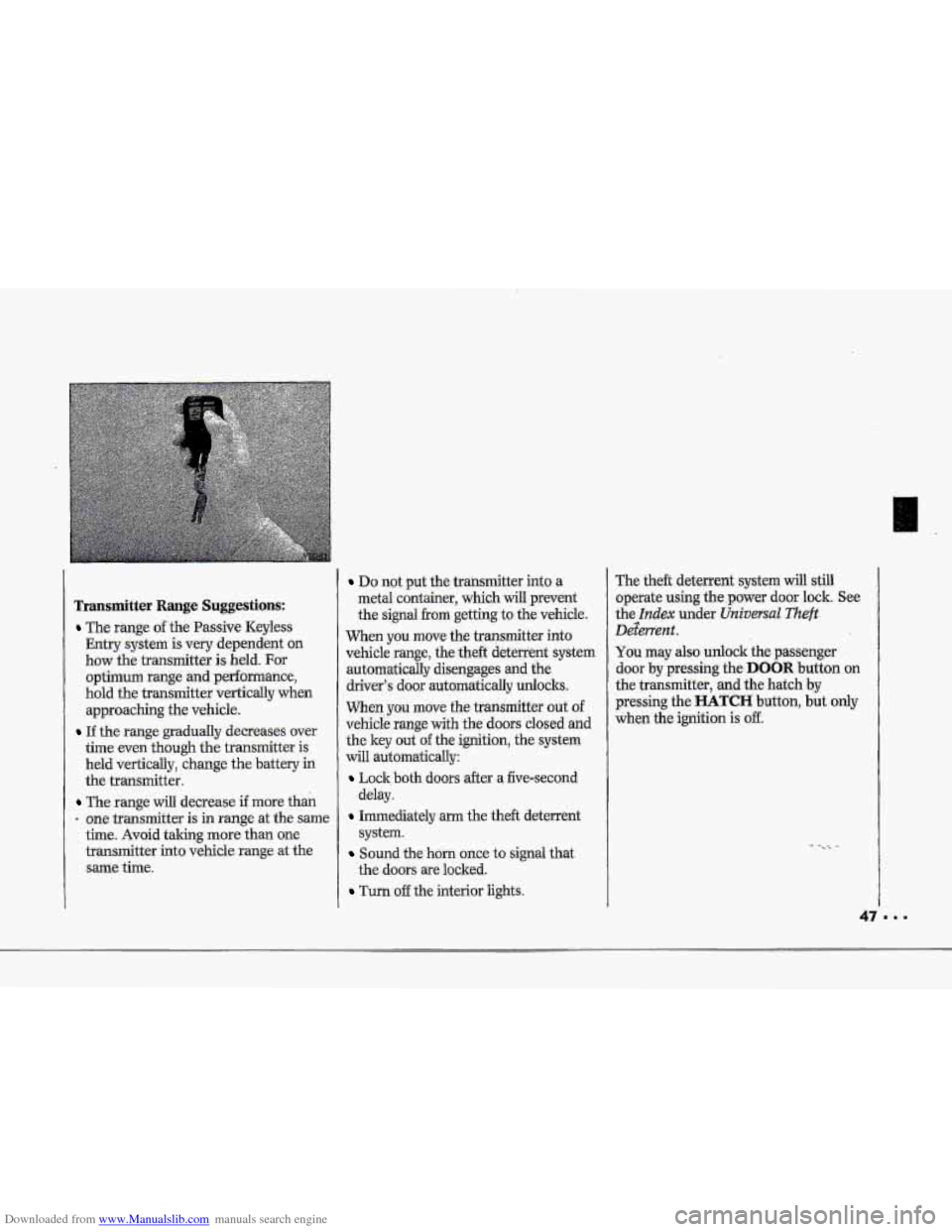
Downloaded from www.Manualslib.com manuals search engine i"" V'
r"
Transmitter Range Suggestions:
The range of the Passive Keyless
EMry system is very dependent on
bow
the transmitter is held. For
opthum range hd performance,
hold the transmitter
vertically when
approaching the vehicle.
If the range gradually decreases over
time even though the transiitter is
held
vertically, change the battery in
the transmitter.
The range will decrease if mure than
one3ransmitter is in range at the same
time.
Avoid taking more than one-
transmitter into vehicle range at the
same time.
Do not put the transmitter into a
metal container, which
will prevent
the
.signal from getting- to the vehicle.
hen you move the transmitter into
vehicle range, the
theft deterrent system
automatically disengages and the
driver's door automatically unlocks.
When you move the transmitter out of
vehide range with the' do.ors closed and
the
key out af the ignition, the system
will automatically:
Lock both .dooxs after -a five-second
Immediately arm the theft deterrent
Sound the horn once to signal that
Turn-off the interior lights.
delay.
system.
the doors are locked.
The theft deterrent system will still
operate using the .pma d0.w lock. See
the Index under .Universal The#?
DeZerrenzt.
You mEQT also Llnbclr the passenger
door by pressing the-DOOR-buttoil Qn
the transmitter, and the hatch by
pressing the HATCH button, but only
when the ignition is off.
Page 93 of 370
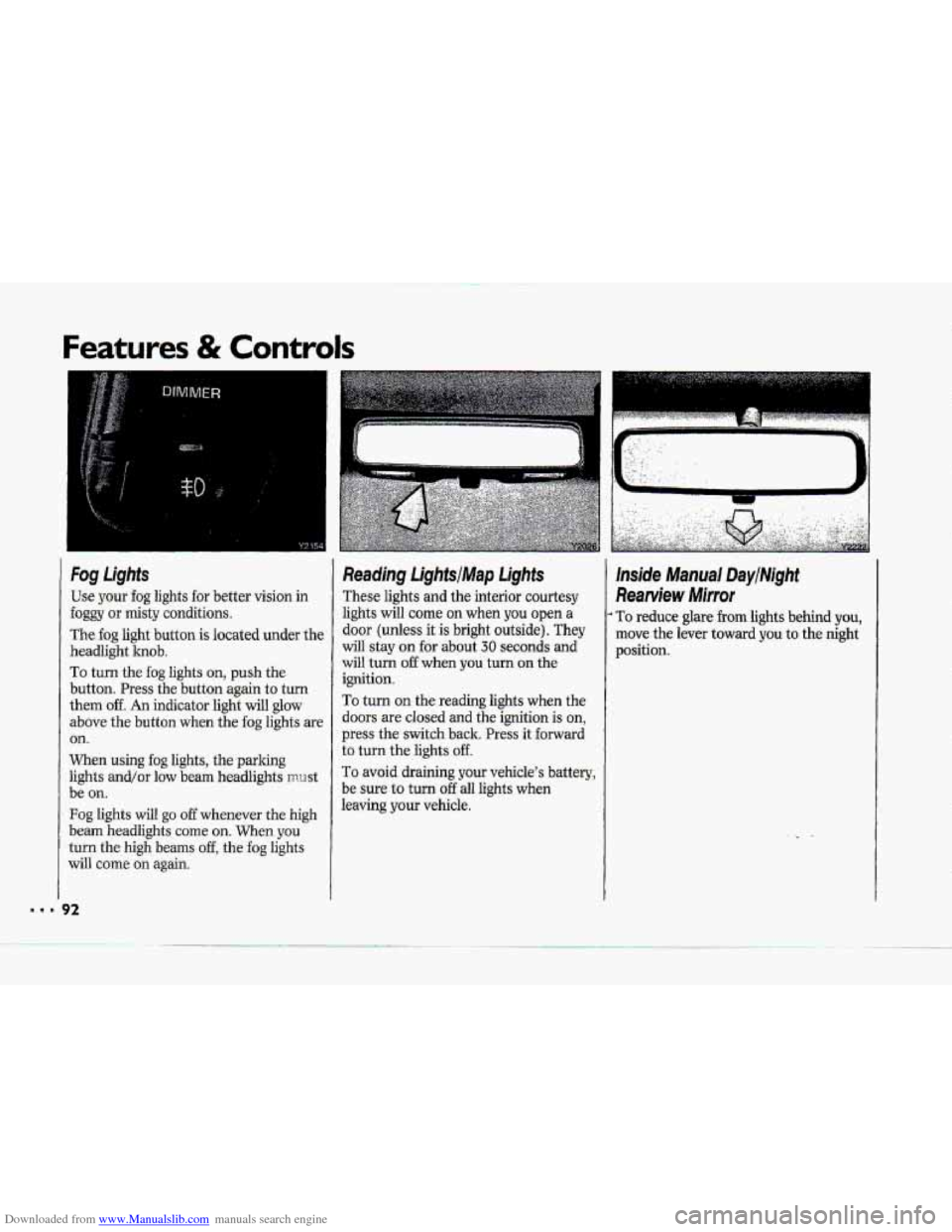
Downloaded from www.Manualslib.com manuals search engine Features & Controls
Fog Lights
Use your fog lights for better vision in
foggy or misty conditions.
The fog light button is located under the
headlight knob.
To turn the fog lights on, push the
button. Press the button again
to turn
them off. An indicator light will glow
above the button when the fog lights are
on.
When using fog lights, the parlung
lights and/or low beam headlights mrrst
be
on.
Fog lights will go off whenever the high
beam headlights
come on. When you
turn the high beams off, the fog lights
will come
on again.
Reading LightsIMap Lights
These lights and the interior courtesy
lights will corne
on when you open a
door (unless it is bright outside). They
will stay on for about 30 seconds and
will turn
off when you turn on the
ignition.
To turn on the reading lights when the
doors
are closed and the ignition is on,
press the switch back. Press it forward
to turn the lights off.
To avoid draining your vehicle's battery,
be sure to turn
off all lights when
leaving
your vehicle.
lnside Manual DaytMght
Rearview Mirror
To reduce glare from lights behind you,
move the lever toward you to the night
position.
Page 141 of 370
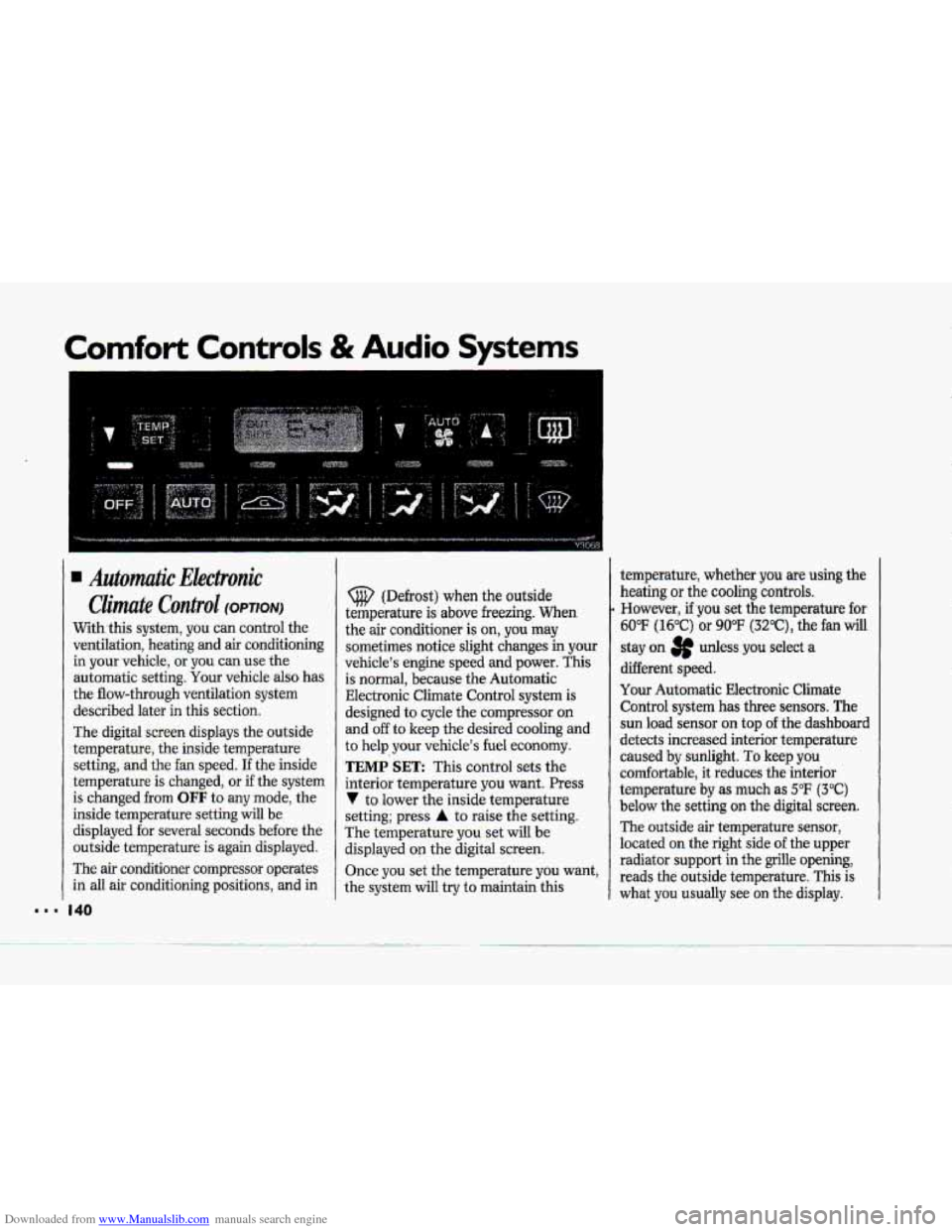
Downloaded from www.Manualslib.com manuals search engine Comfort Controls & Audio Systems
... I..
1. 140
Automutic Ekctronic
Climate Control (OPTION)
With this system, you can control the
ventilation, heating
and air conditioning
in your vehicle, or you can use the
automatic setting.
Your vehicle also has
the flow-through ventilation system
described later
in this section.
The digital screen displays the outside
temperature, the inside temperature
setting, and the fan speed.
If the inside
temperature is changed,
or if the system
is changed from
OFF to any mode, the
inside temperature setting will be
displayed for several seconds before the
outside temperature is again displayed.
The
air conditioner compressor operates
in all air conditioning positions, and in
(@ (Defrost) when the outside
temperature is above freezing.
When
the air conditioner is on, you may
sometimes notice slight changes in your
vehicle's engine speed and power. This
is normal, because the Automatic
EIectronic Climate Control system
is
designed to cycle the compressor on
and off to keep the desired cooling and
to
help your vehicle's fuel economy.
TEMP SET: This control sets the
interior temperature you want. Press
V to lower the inside temperature
setting; press
A to raise the setting.
The temperature
you set will be
displayed on the digital screen.
Once you set the temperature you want,
the system will try to maintain this temperature,
whether
you are using the
heating
or the cooling controls.
However, if you set the temperature for
60°F (16°C) or 90°F (3Z°C), the fan will
stay on 3p udess you select a
different speed.
Your Automatic Electronic Climate
Control system
has three sensors. The
sun load sensor on top of the dashboard
detects increased interior temperature
caused by sunlight.
To keep you
comfortable, it reduces the interior
temperature
by as much as 5°F (3°C)
below the setting on the digital screen.
The outside air temperature sensor,
located on the right
side of the upper
radiator support
in the grille opening,
reads the outside temperature.
This is
what you usually see on the display.
Page 142 of 370
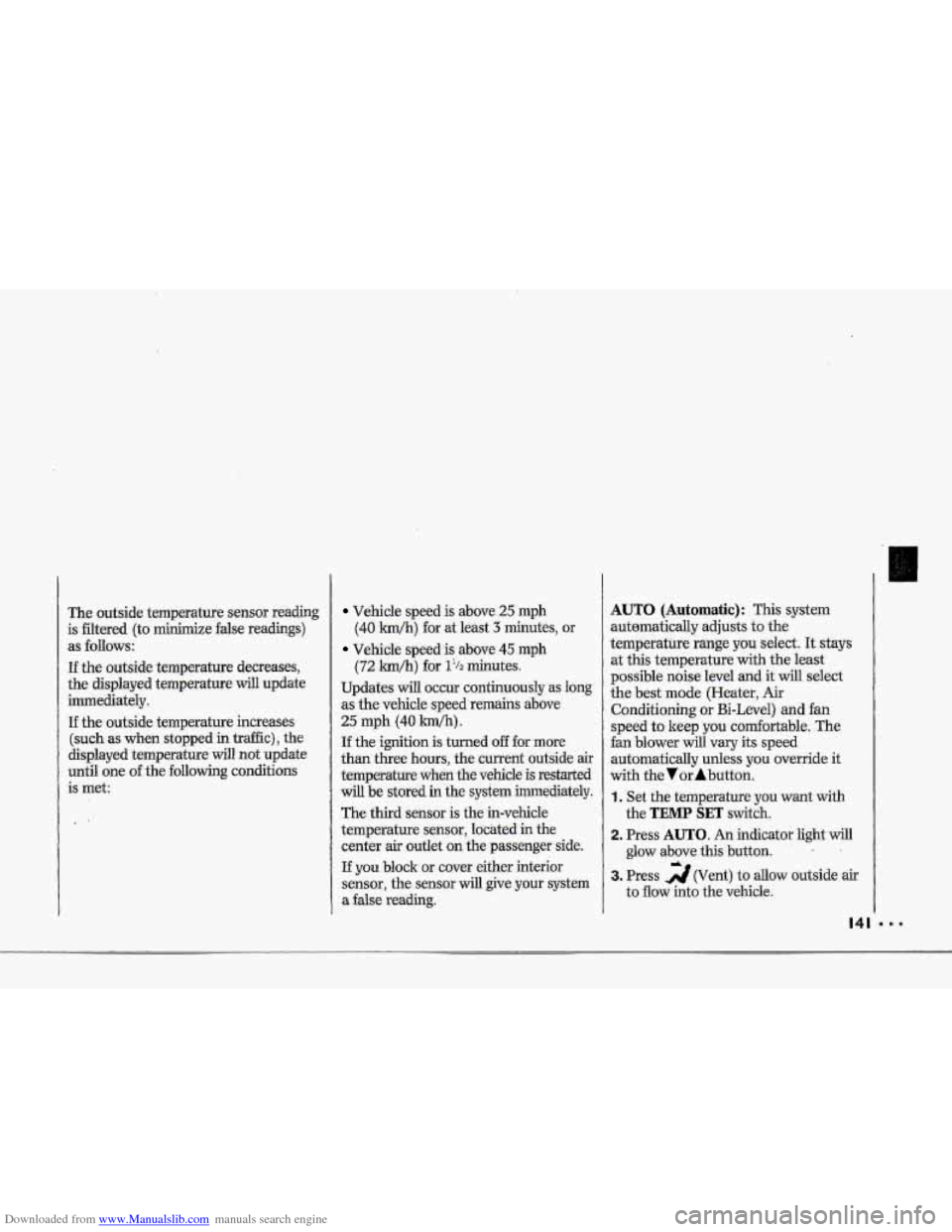
Downloaded from www.Manualslib.com manuals search engine 4
$"
i i
I i
?- i
i
i I
r I
r"
!
The outside ternperatufe sensor reading
is filtered (to minimize false readings)
as follows:
If- the outside temperature decreases,
the -&splayed temperature
will update
immediately.
I€- the outside temperature increases
(such as when stopped in traffic), the
displayed temperature will not update
until one
of the following eonditiom
is met:
Vehicle speed is above 25 mph
Vehicle speed 'is above 45 mph
Updates will occur continuously as long
as the vehicle speed remains above
25 mph (40 Wh).
zf the ignition is turned off for more
than three hours, the current outside air
tempepature when the vehicle is restarted
will be stored in the system immediately.
The third sensor
is the in-vehicle
tempefature sensor, located
in-the
center air outlet on the passenger side.
If you block or cover either interior
sensor, the sensor
will give your system
a false reading.
(40 ,nn/h) for at least 3 minutes, or
(72 krn/h) for 1% minutes.
AUTO (Automatic): This system
autmnatically
adjusts to the
temperature range you select.
rt stays
at. this temperature
with the least
possible noise level
and it will select
the best mode (Heater,
Air
Conditioning or Bi-Level) and fm
speed to keep you comfortable. The
fan blower
will vary its speed
automatically unless you ovenide
it
with theVqrAbutton,
1 .I Set the temperature you want with
2. Press AUTO. An indicator light will
3. Press A (Vent) to allow outside. air
the
TEMP SET switch.
glow above
this.hutton.
to
flaw into the vehicle.
d
Page 143 of 370
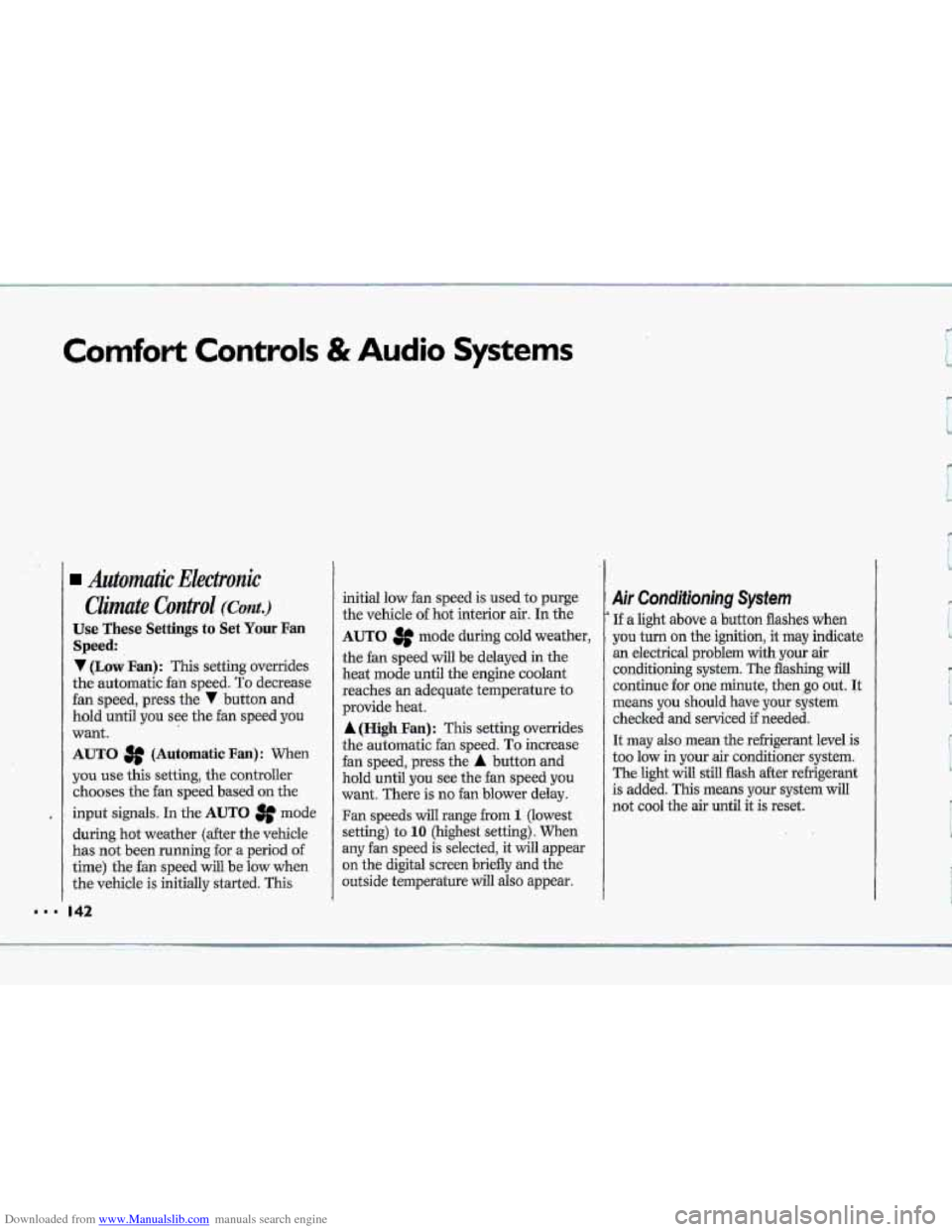
Downloaded from www.Manualslib.com manuals search engine Comfort Controls & Audio Systems
Automutic Electrunic
Climate Cuntvul (C0nt.j
Use These Settings to Set Your Fan
Speed
V (Lqw.Ean): 'This. setting overrides.
the automatic fan speed. To decrease
fan speed, press the
V button and
hold until
you see the fan speed you
want.
AUTO # (Automatic Fan): when
you use this setting, the controller
chooses the fan speed based on the
input signals.
In the AUTO mode
during hot weather (after the vehicle
has not been running for a period of
time) the-fan speed will be
low when
the vehicle is initially
started. This
I42
initial low fan speed is used to purge
the vehicle of hot interior air. In the
AUTO 3f mode during cold weather,
the
fan speed will be delayed. in the
heat
mode until the engine coolant
reaches
an adequate temperature to
provide heat.
A (High .Fan) : This setting overrides
the automatic fan speed. To increase
fan speed, press the A button and
hold until you see the fan speed you
want. There is no €an blower delay.
Fan speeds wil1 range from 1 (lowest
setting)
to 10 (highest setting). When
any fan speed is selected, it will appear
on the digital screen briefly and the
ot~tside temperature will also appear.
Air Conditioning System
If a light above a button flashes when
you turn
on the ignition, it may indicate
an electrical problem with your air
conditioning system. The flashing will
continue for one minute, then go but. It
means you should have your system
checked
and serviced if needed.
It may
also mean the rekigerant level is
too low in your air conditioner system.
The. light will still flash after rebigerant
is added. This means your system will
not cool the air until it is reset.
Page 195 of 370
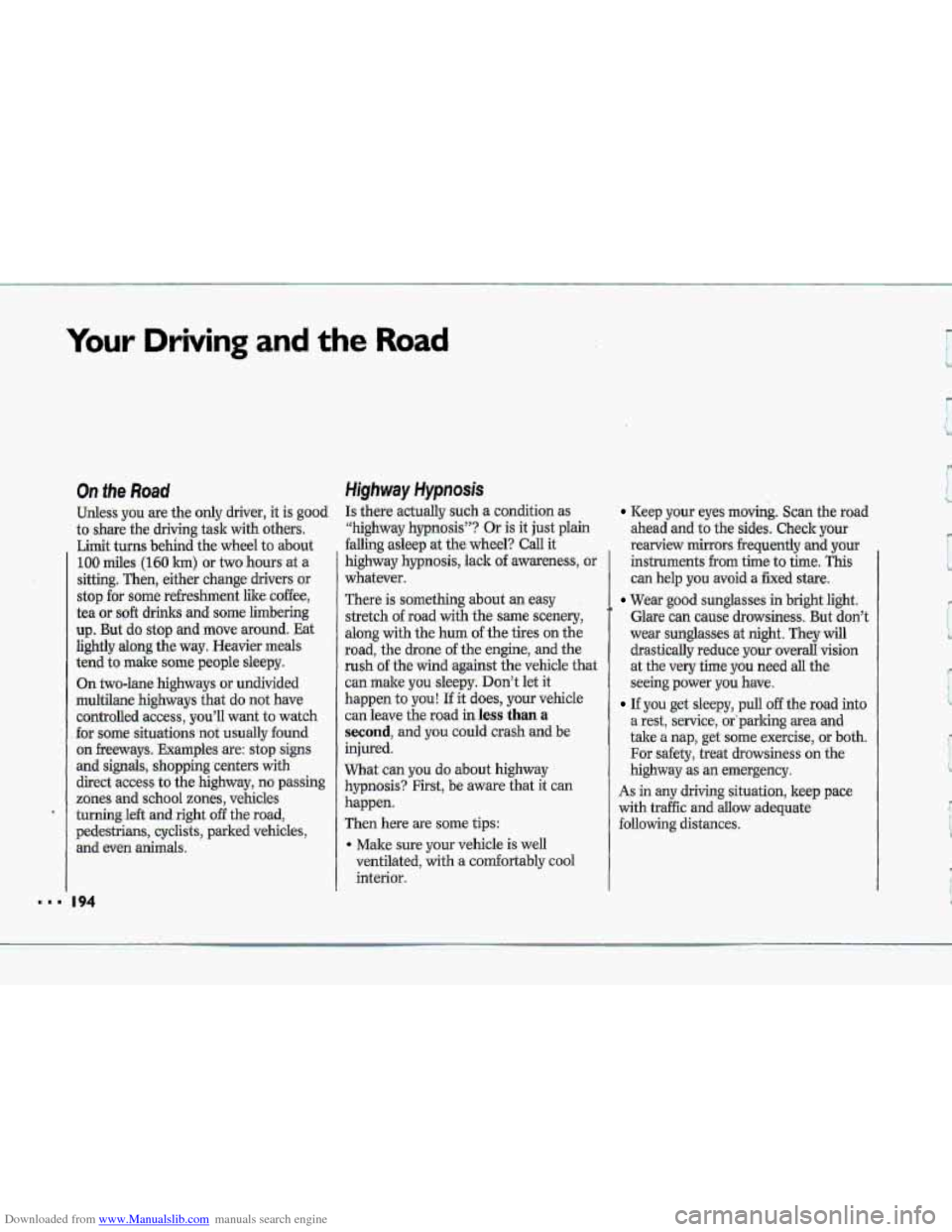
Downloaded from www.Manualslib.com manuals search engine Your Driving and the Road
On She Road
Uidess you are the -only driver, it is good
to share the driving task with others.
Limit turns behind
the wheel to about
100 miles (160 km) Or two hours at a
sitting.-Then, either change drivers ar
stop for some rdreshment like coffee,
tea or
soft drinks and some limbering
up.
But do stop and move around. Eat
lightly along the way. Heavier meals
tend to
mdke some people sleepy.
On two-lane highways or
undivided
multilane highways that do not have
controlled .access,.you’ll
wmt to watch
for some situations :not usustlly found
on freeways. Examples: are: stop signs
and signals, shopping tenters with
direct access
to the highway, no passing
zones and school zones, vehicles
turning
le& and- right off the-road,
pedestrians, cyclists, parked vehicles, and even a&&.
Highway Hypnosis
Is thete-actually such a condition as
“highway hypnosis”? Or
is it just plain
falling asleep at the wheel? Call it
highway hypnosis, lack
of awareness, or
whatever.
There is
something about an easy
stretch
of road with the same scenery,
along with the
hum of the tires on the
road, the drone of the engine; and the
rush of the wind against the vehicle that
can make you sleepy. Don’t let it
happen
to you! If it does, your vehicle
can leave the road in less than a
second, and you could crash and be
injured.
What can you do about highway
hypnosis? First, be aware that it can
happen.
Then here
are some tips:
4 Make sure your vehicle is well
ventilated,
with a comfortably cool
interior.
Keep your eyes moving. Sca.n the road
ahead and
-to the sides. Check your
rearview mirrors frequently and your
instruments from time to time. This
can help you avoid
a fixed stare.
Wear good sunglasses in bright light.
Glare can cause drowsiness. But
don’t
wear sunglasses at night. They will.
drastically reduce-your,overall.~sion
at the very time you need all the.
seeing power
you have.
If you get sleepy, pull off the road into
a rest, service, &‘parking area and
take a nap, get so.me exercise, or both.
For safety, treat drowsiness on the
highway
as an emergency.
As in any driving situation, keep pace
with traffic and allow adequate
foIlowing distances.